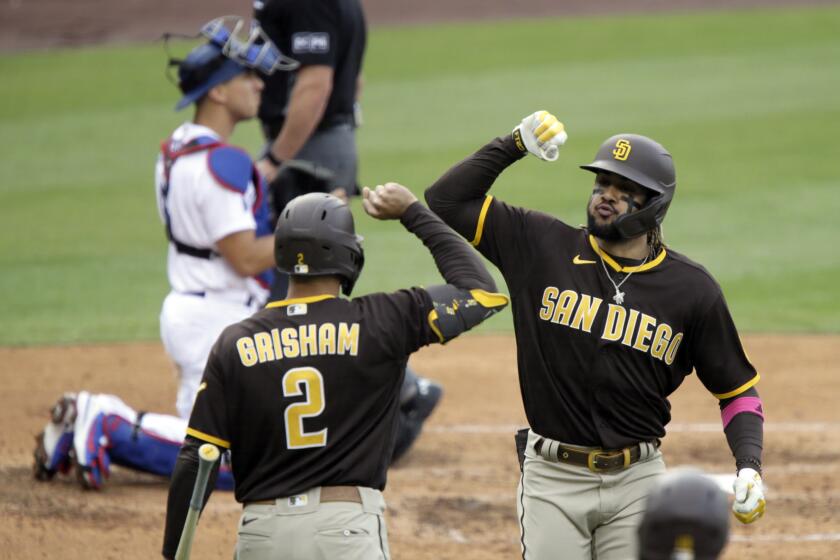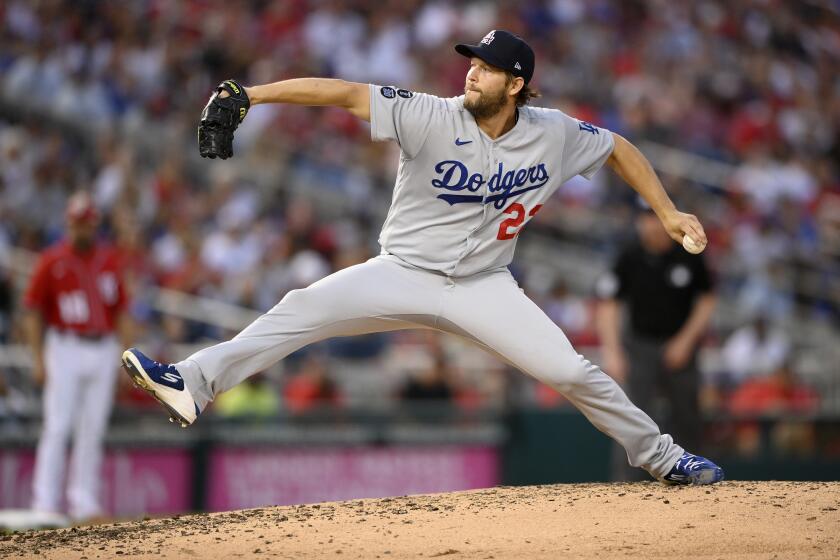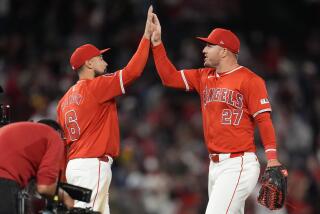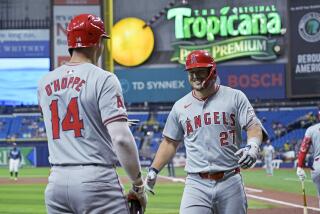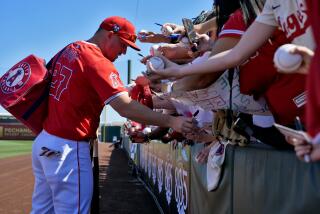Five observations about the Angels as they start the second half of the season
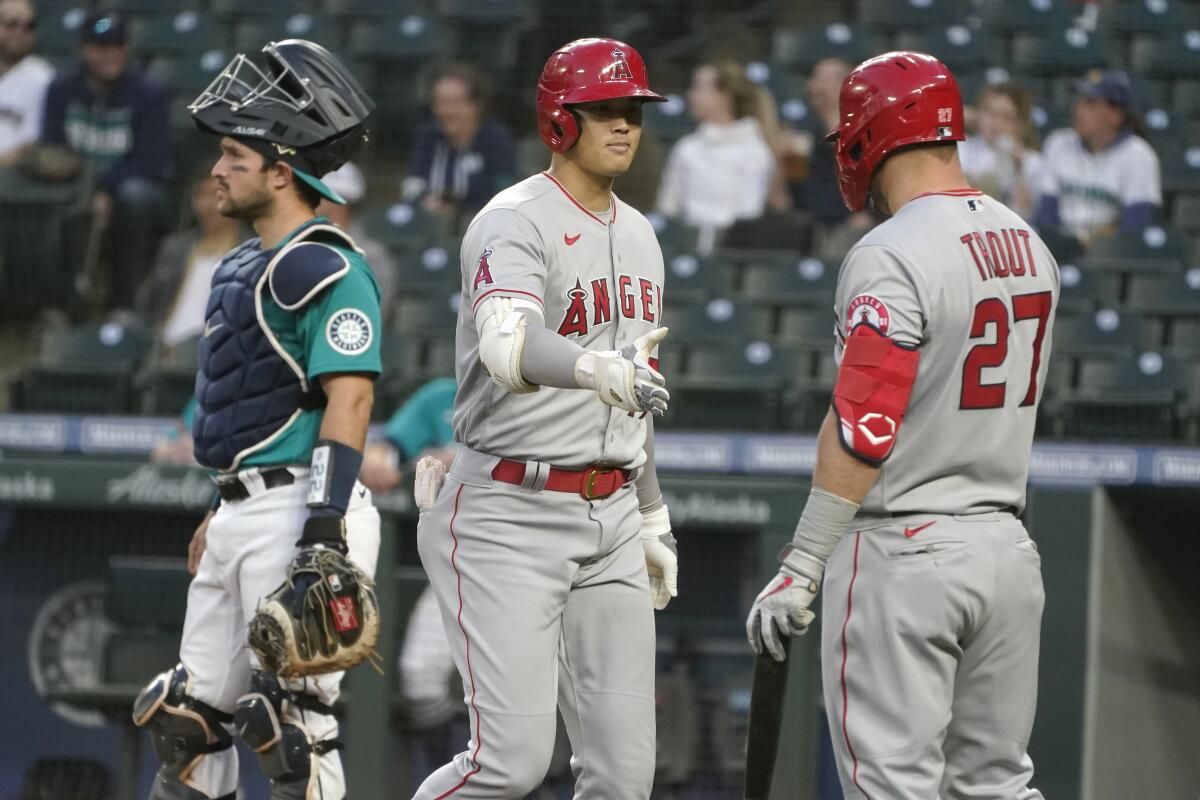
- Share via
The best way to describe the Angels’ first half of the season: survival.
They dealt with key injuries to several stars and inconsistencies from their role players. They managed repeated shuffling to their roster and struggles on the mound. They overcame a poor start in the two months to reach the All-Star break over .500.
Manager Joe Maddon’s evaluation: “We got better. [That] is probably the best way to look at it.”
But another 2 1/2 months to go, and plenty of questions left to be answered, the Angels aren’t out of survival mode yet.
As they begin the second half of the season, here’s a look at where they’re at and what they need to do to make a legitimate playoff push down the stretch.
Success at the plate
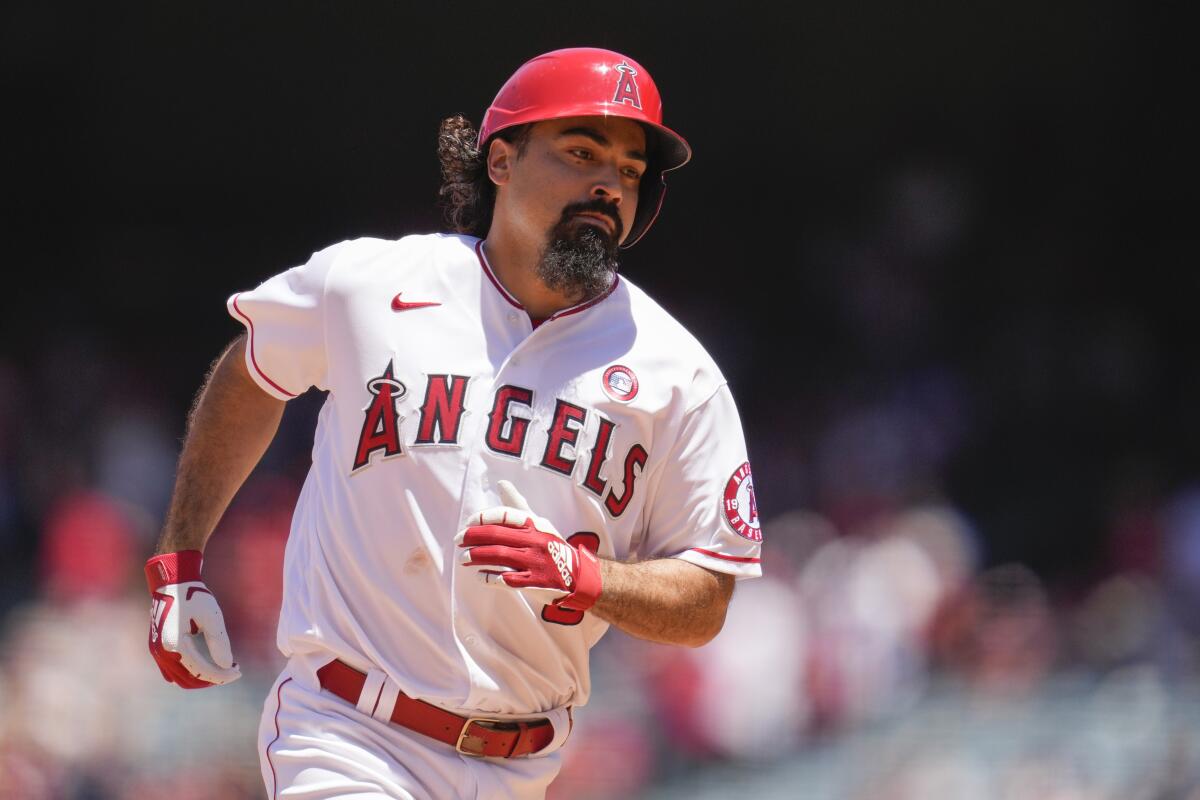
Of the nine players in the Angels opening day lineup, only three avoided a trip to the injured list during the first half of the season.
Albert Pujols, who is no longer with the club. David Fletcher, who only briefly missed a handful of games with a hip injury in May. And Shohei Ohtani, who played in 87 of the team’s first 89 games but also skipped a couple pitching starts with a blister.
The other six — Max Stassi, José Iglesias, Anthony Rendon, Justin Upton, Mike Trout and Dexter Fowler — have combined to miss more than 200 games.
Fowler suffered a season-ending injury in April. Trout has been out since May with a calf strain. Stassi hardly played prior to June because of a thumb sprain and concussion. And Rendon entered the All-Star break in the midst of his third IL stint.
The good news? It hasn’t kept the club from posting strong numbers at the plate. The team is top-10 in the majors in scoring (4.89 runs per game), batting average (.257), on-base-plus-slugging percentage (.759) and home runs (123).
The NL West might produce three playoff teams and the Yankees could be a .500 team. Here’s five observations about the first half.
They’ve been good in clutch situations. With runners in scoring position, they have the best average and second-best OPS. In the seventh inning or later, they have the third-best average and 12th-best OPS.
And while they haven’t walked much (their 7.4% walk rate is last in the majors), they haven’t struck out much either (their 23% strikeout rate is 13th best). Instead, they’ve been one of the most aggressive teams at the plate, swinging at the 10th-highest rate and making contact at the second-highest rate.
Ohtani and Jared Walsh — the team’s two healthy All-Stars and leaders among qualified batters in OPS, RBIs and home runs — have carried most of the load since Trout went down. When healthy, Upton and Stassi have also been productive.
It’s perhaps the Angels’ biggest reason for optimism entering the second half, when they expect to have Rendon back as soon as this weekend, and hope Upton and Trout will return soon after.
Struggles in the field
The defense hasn’t been nearly as effective at overcoming the rash of injuries.
While they made some improvements in recent weeks, the Angels still entered the break with some of the worst defensive metrics in the league.
Their .982 fielding percentage is 22nd in baseball. According to Sports Info Solutions, they have negative-17 defensive runs saved, the sixth-worst mark in the majors. And in Fangraphs’ defensive ratings, they ranked second-worst ahead of only the Detroit Tigers.
As expected, their worst-rated positions have been at catcher, where Stassi has missed 38 games; third base, where Rendon has missed 26 games; and the outfield, which has required a patchwork effort at times with such players as Taylor Ward, Luis Rengifo, Jose Rojas and Phil Gosselin playing out of their normal positions.
Some of their regulars — such as Iglesias, whose 11 errors are tied for seventh-most in the majors, and Upton, who ranks in the bottom 10% of the majors according to MLB’s Statcast system in outs above replacement — have struggled too.
Maddon has repeatedly acknowledged the need to do better at “catching the ball on a nightly basis,” but also pointed to steady improvements in how the Angels have positioned their outfield and utilized the infield shift (Sports Info Solutions gives them the fourth-best infield shift rating in the majors).
Once again, their success in the field could depend on their ability to stay healthy and keep players in their natural positions.
Reshuffled rotation
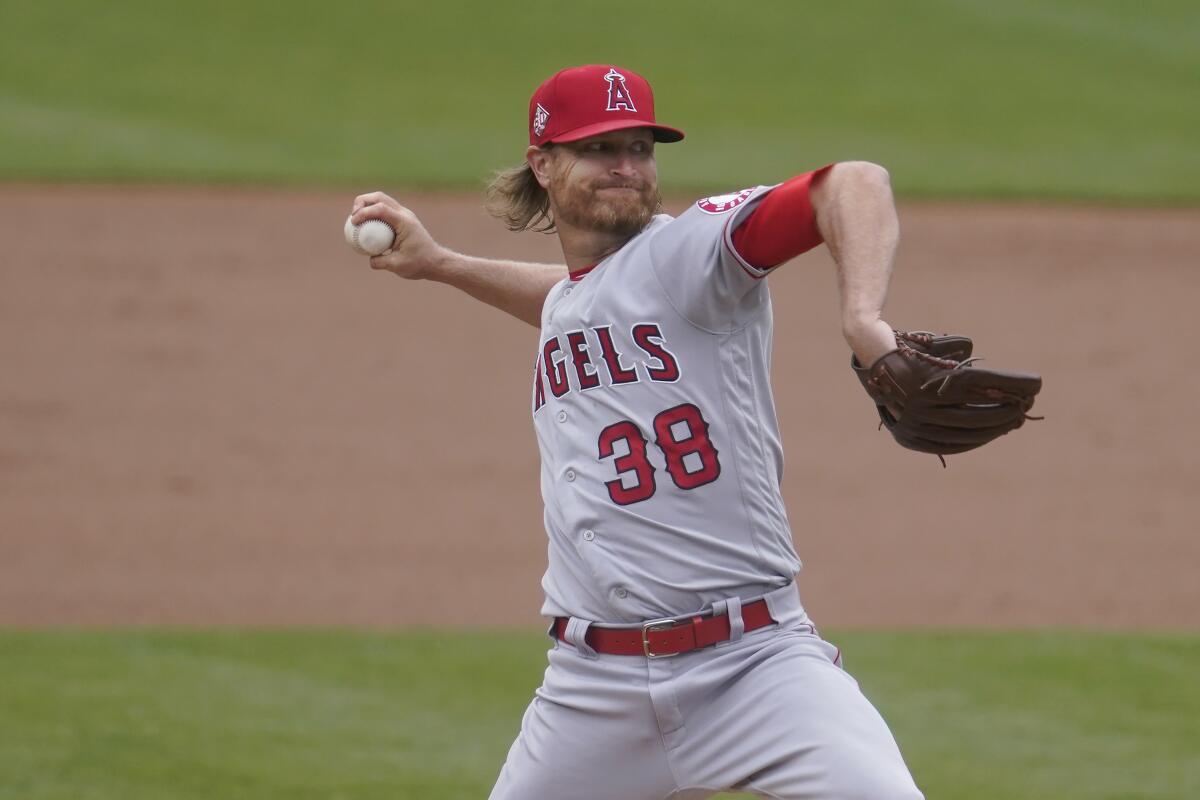
Overall, the Angels’ pitching has been a sore spot so far this season, ranking 20th or worse in the majors in earned-run average (4.90), opponent batting average (.246) and walks-plus-hits-per-inning (1.40).
But, after making several changes to the rotation over the last month, the team enters the second half with a group of seemingly dependable — if not dominant — starting pitchers.
Ohtani has been the anchor, with a 3.49 ERA, 87 strikeouts and 4-1 record over his first 13 starts. Alex Cobb has also been solid, with a 4.23 ERA, 74 strikeouts and 6-3 mark over his first 13 starts.
And while Andrew Heaney has been more inconsistent, posting a 5.38 ERA despite recording 94 strikeouts and a 5-6 record in 15 starts, the two new additions to the rotation have made strong first impressions after replacing struggling veterans.
Patrick Sandoval has made nine straight starts since May 17, initially filling in because of injuries before taking José Quintana’s rotation spot. In each outing, the 24-year-old left-hander has given up three or fewer earned runs. And in the last eight, he’s gone at least five innings.
Another young left-hander, 23-year-old José Suarez, entered the rotation in favor of Dylan Bundy earlier this month after a strong start to the season in the bullpen, and has given up just three runs in eight combined innings in his first two starts.
Prior to the All-Star break, Maddon said the Angels — who this month also optioned Griffin Canning, who on Thursday was put on the injured list in Triple A with a lower back strain — will probably return to a six-man rotation after this week’s upcoming off day.
But for now, of their current five man group, only Heaney has a below-league average rating in the all-encompassing ERA+ statistic. And over the first nine games in July, Angels starting pitchers have a 3.56 ERA that ranks 10th in the majors.
Bullpen inconsistencies
While the rotation has seemingly turned a corner, the bullpen remains more of a work in progress.
Closer Raisel Iglesias has been lights out since late April, converting 17 of his last 18 save opportunities with a 2.60 ERA and 52 strikeouts in his last 29 outings.
Everyone in front of him, though, has gone through ups and downs.
Primary set-up man Mike Mayers has a 4.64 ERA. Left-hander Tony Watson has a 4.60 ERA, though that number was ballooned by a six-run, no-out outing in June in Oakland.
Right-hander Steve Cishek has been the most consistent middle reliever, with a bullpen-low 2.88 ERA in a team-high 45 appearances.
But overall, Angels relievers rank 22nd in the majors in combined ERA (4.70), 22nd in opponent batting average (.241), 23rd in walk rate (11.1%) and 25th in strikeout rate (22.7%).
They’ve also struggled with inherited runners, allowing 40% of them to score (23rd-worst in MLB).
The Dodgers have issues with their rotation and the offense has been inconsistent. Still, they open play after the All-Star break only two games out of first.
Long odds in playoff race
The Angels aren’t out of the playoff race, but they’re barely hanging on in the standings.
They entered the All-Star break nine games behind the Houston Astros in the American League West and 5 1/2 behind the Oakland Athletics for the second wild-card spot, with four other teams also ahead of them.
Oakland is on pace to win 91 games. For the Angels to reach that mark, they’d have to go 46-27 over the second half of the season.
That would mean posting a .630 winning percentage over the final 73 games. For reference, even while playing nine games over .500 since May 23 — when they were a season-worst eight games under .500 — the Angels have only had a .605 winning percentage in the 43-game stretch.
“I know conventional wisdom would indicate that it’s very difficult to achieve where you want to get this year,” Maddon said Sunday. “I understand that, but I’ve been there before. And I know it’s possible.”
The first step will be playing well ahead of the July 30 trade deadline. General manager Perry Minasian said it’s realistic the Angels could attempt acquiring big league help if they’re still in the race by then. But if they’re not, he could have potential trade pieces to deal away too, including players on expiring contracts such as Raisel Iglesias and Cobb.
If the Angels can get through that, they’ll be hoping a healthy lineup that by then could include Rendon, Trout and Upton, plus improved performance on the mound and in the field, will be able to lift them back into contention.
It’s not impossible — Fangraphs gives the Angels a 15.6% chance of making the postseason — but after surviving through the first half, they’ll need almost everything to go right the rest of the way.
“I think culturally a lot of things are starting to set in,” Maddon said. “I want to believe it’s gonna show up in wins in the second half.”
More to Read
Go beyond the scoreboard
Get the latest on L.A.'s teams in the daily Sports Report newsletter.
You may occasionally receive promotional content from the Los Angeles Times.

